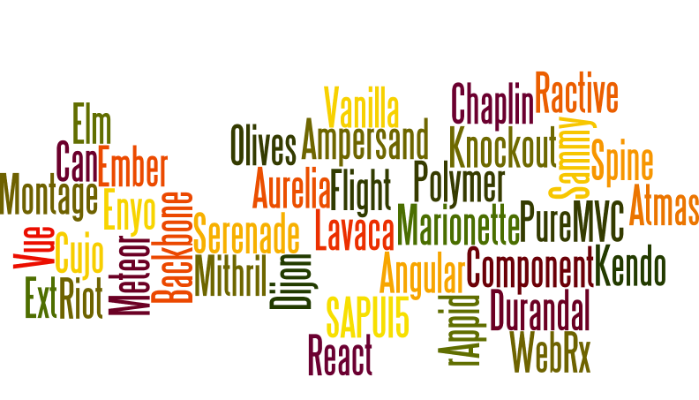JavaScript frameworks learning curve – Angular, Backbone, Ember and React!
by admin
Posted on 08/12/17 1:12 PM

Frameworks! Heard before? Whether it’s a yes or no, I’d like to commence with its true definition – what is it and how it can be useful for us…
| You just need a framework and an idea.
Frameworks are nothing but, basic structures which serve as a foundation for system, concept or text. These are a collection of programs which can help you develop your own applications. It tells you, ‘how to do something when everything is predefined’…like classes and functions which can be used to process input, manage h/w devices or interact with system software.
All in all, Frameworks provide you with the following:
- Easy-working with complex technologies,
- Promotes consistent coding and fewer bugs,
- Makes your app more scalable and flexible.
There are a number of frameworks to choose from. But, Javascript frameworks are one of my favourites and ever since they have continued to evolve at a fever pitch.
Now, If you are in a mood of making a Javascript-based website or application, it’s essential to choose the right framework that best fulfils your project’s needs. Angular.JS, Backbone.Js, Ember.JS, React.Js – are the frameworks that we’ll consider here.
Angular.JS
The frameworks champion
AngularJS is a Superheroic Javacript Framework founded in 2009 by Misko Hevery. It is the oldest of all 4 frameworks mentioned above. It is meant for building high-end Single page applications (SPAs), thereby, extending the functionality of HTML with directives.
Some of the most popular websites using Angular.JS includes Freelancer, Youtube, Vevo, weather, etc.
Benefits:
- Straightforward design,
- Simple routing,
- Runs quickly,
- Easy-to-test code.
Sick Points:
- Learning curve is steep,
- Third party integration is quite complex,
- Tends to be slow sometimes.
For knowing more about Angular, you can check out its homepage at here – https://angularjs.org/.
Note: AngularJS uses Model-View-Controller architecture for Angular 1 and Model-View-ViewModel architecture for Angular 2. Their is drastic differences b/w the two.
Backbone.JS
Very lightweight framework
Backbone.JS is a javascript framework which uses Model-View-Presenter design approach. It is lightweight and ideal for making Single page web applications. Backbone framework was built by ‘Jeremy Ashkenas’ ( A famous developer who is well-known for developing CoffeeScript & Underscore.JS. )
It brings with itself, huge number of advantages:
- Easily sync with the back-end,
- Great support for Restful API’s,
- Maintains clean code,
- Highly efficient with readable code,
- Provides extensibility and versatality.
And, there are number of apps which have been developed using it. Some of them are – Airbnb, Foursquare, etc.
React.JS
A newbie on the block
React.JS is used for building interfaces. It is highly focussed on ‘V’ in Model-View-Controller architecture. Created by Jordan Walke, react.js was open sourced in 2013.
It is often used with other Javascript frameworks for large applications whose data-set change frequently. Number of popular websites built using React.js includes – Flipkart, Instagram, Facebook, New York Times, Airbnb, etc.
Benefits:
- Good for javascript debugging,
- Provides faster updates,
- Significant performance gains.
Sick Points:
- Not fully framework, but, more of a library,
- Has steep learning curve,
- View layers are very sophisticated.
For more on React, check out its main website at here: https://reactjs.net/.
Ember.JS
All focussed on scalability
Ember.JS uses Model-view-controller design approach for developing client side SPA’s (Single page applications). Originally, in 2007, Ember came into existence as ‘SproutCore’. In 2011, Facebook acquired and renamed it as Ember.
Benefits:
- Proffer URL support,
- Scale web app beyond the view layer,
- Incorporates friendly docs and API,
- Provides faster boot time and stability.
Sick Points:
- Has steep learning curve,
- Contains lot of outdated content,
- Cumbersome,
- Most heaviest of frameworks.
Wrapping Up: Angular is most popular of all four. It can be used as one-stop-shop for large enterprises. Ember has, in comparison to others, more learning curve. So, it is ideally suited for long-term projects. React is lightest of all frameworks, and thus, are responsible for doing one great thing – rendering UI components. And, it’s pretty easier to create your SPA using Backbone.Js. Finally, it’s all your decision of which Javacript Framework to pick.
Hope you liked my #same post. Provide me your valuable comments or let me know if their are any eyesores. I am eager to answer you!
Categories
-

JavaScript Frameworks
02/27/24 12:46 PM
-

API First Development
02/22/24 6:19 AM
-

Mobile Commerce: The Future of Online Shopping
02/22/24 6:09 AM
-

What is ChatGPT? Exploring the Latest Trends
02/22/24 5:57 AM
-

The Power of AI in App Development
02/5/24 7:44 AM
